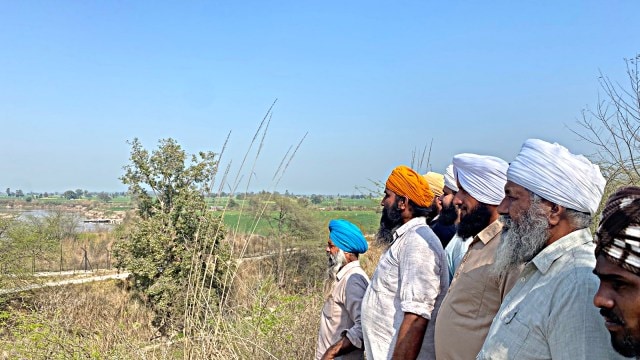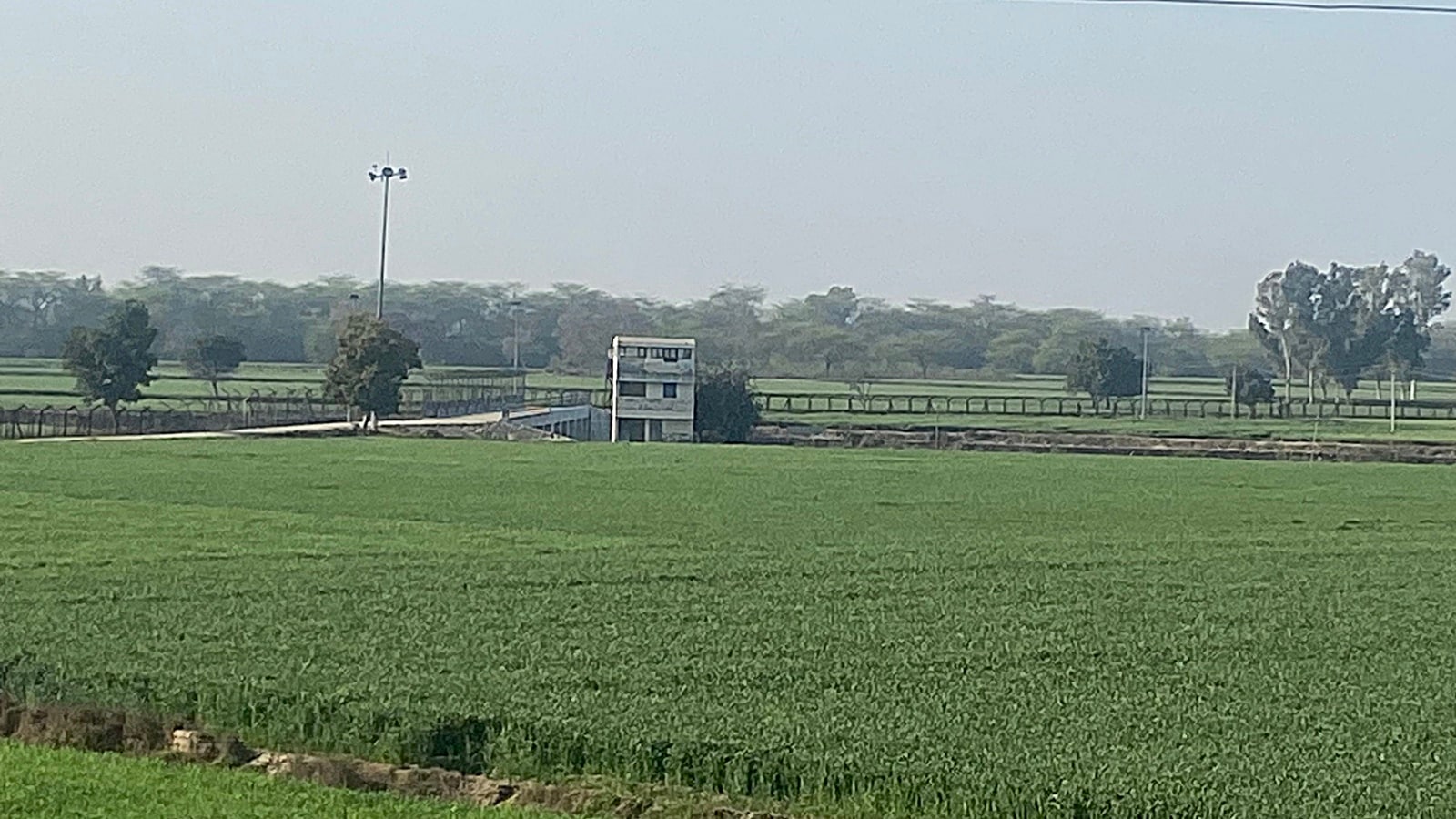In Punjab and Jammu, security fence may be moved closer to border with Pakistan
For farmers based in Fazilka, Ferozepur, Tarn Taran, Amritsar, Gurdaspur and Pathankot districts of Punjab, shifting of the fence will mean freedom from wild boars and drones, both from Pakistan.
 Farmers stand facing the border with Pakistan at Kakar village in Amritsar sector. (Express Photo by Man Aman Singh Chhina)
Farmers stand facing the border with Pakistan at Kakar village in Amritsar sector. (Express Photo by Man Aman Singh Chhina)The Border Security Force (BSF) and the Ministry of Home Affairs (MHA) are “actively considering” a proposal to shift the security fence closer to the International Border (IB) with Pakistan in Punjab and parts of Jammu region.
Special Director General, Western Command, BSF, Y B Khurania confirmed that proposals regarding moving the fence towards the IB in Punjab and Jammu have been submitted to the government. “This involves issues like acquisition of land and compensation. The BSF is also in favour of moving the fence ahead wherever it can be done,” he said at an annual press conference held recently.
A BSF officer told The Indian Express that the move will help farmers in six Punjab districts access their fields in the restricted area (between the security fence and the IB) more easily and also keep them safe from wild boars that destroy crops and attack them.
A senior BSF officer at the force’s Punjab frontier headquarters in Jalandhar told The Indian Express, “This move will also help the manner in which border patrolling and management are done.”
Unwanted ‘guests’ from Pakistan
As per the Punjab Border Area Kisan Union, nearly 45,000 acres of fertile government and private land falls in the restricted area. The undulating fence along the 461-km IB with Pakistan was erected between 1988 and 1993 to protect Punjab when militancy was at its peak in the state. Due to the uneven terrain, the distance between the fence and the IB varies from a few feet at some places to nearly 2 km at others.
For farmers based in Fazilka, Ferozepur, Tarn Taran, Amritsar, Gurdaspur and Pathankot districts of Punjab, shifting of the fence will mean freedom from wild boars and drones, both from Pakistan. While the animals destroy crops and gore farmers working on the portions of their fields falling in the restricted area, drones often use the villages there as drop zones for smuggled drugs and weapons.
Kals village resident Gursewak Singh, whose 11 acres fall in the restricted area, said, “Wild boars from Pakistan destroy nearly 60-70 per cent of the crop growing on the restricted land but we do not receive any compensation. These animals also attack farmers. We have reported this to the government, including the Deputy Commissioner, on multiple occasions.”
 The fence at India-Pakistan border in Tarn Taran sector near Punjab’s Kals village. (Express Photo by Man Aman Singh Chhina)
The fence at India-Pakistan border in Tarn Taran sector near Punjab’s Kals village. (Express Photo by Man Aman Singh Chhina)
His village is so close to the IB that residents can hear the hum of traffic on Pakistan’s Lahore-Kasur Road. But the noise that actually bothers them is one made by drones. Residents say they can hear the drones but can’t see them since these devices become active only at night.
Sarabjeet Singh, a local resident, said a drone hovered over a house in the village at night a few months ago, dropped some packets of drugs and flew away. “Luckily, the family inside the house was awake and reported the incident immediately,” he said.
“Our villages get a bad name because of these drug drops. Earlier, smugglers used plastic pipes across the fence to drop drugs or weapons in our fields. Now, they are using drones,” he said.
Seizures and surveillance
According to data released by BSF’s Western Command, 97 drones and 755 kg of narcotics have been seized so far this year. The data also revealed that 15 assorted rifles and 38 pistols have been seized, 36 Pakistani nationals held and nine Pakistani intruders killed along the IB/Line of Control so far this year.
Special DG Khurania said vulnerability mapping has been carried out along the India-Pakistan border to strengthen surveillance by deploying vehicles and additional special surveillance teams 5-6 km from the border. BSF officials say integrated surveillance technology, complete with CCTV/pan-tilt-zoom cameras, infrared sensors and infrared alarms with Command and Control System, is also being installed at the IB.
Surjit Singh Bhura, the vice-president of Punjab Border Area Kisan Union, said the farmers will wholeheartedly welcome the move to realign the fence.
“We have observed fewer cases of smuggling in areas where the fence is closer to the border. According to government rules, the fence should be at least 50 metres from the IB and at a maximum distance of 150 metres. If you walk along the fence today, it is 2 km from the border at places,” he said.
Farmers say the move will also alleviate the problem of restricted access to their land. Gates that currently grant access to the restricted land are opened for farmers for a few hours on designated days of the week. However, there are restrictions on the number of people who can work close to the border and the number of tractors they can take to till their land.







